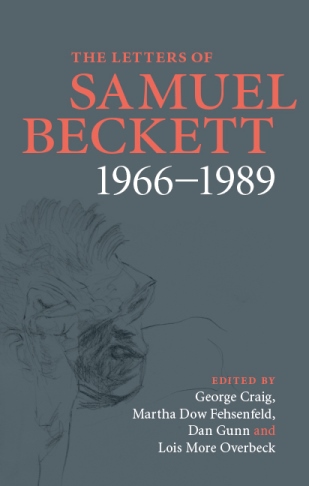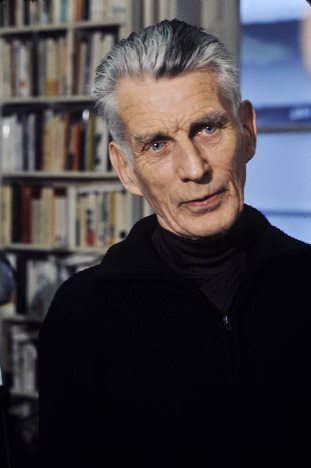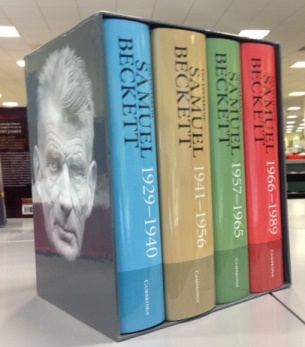Celebrating Samuel Beckett

The Laney Graduate School and the Letters of Samuel Beckett Project are pleased to celebrate the publication of The Letters of Samuel Beckett, 1966–1989 by Cambridge University Press, the fourth and final volume of the Letters editions.
Each volume spans critical periods of Beckett’s work. Volume IV reflects increased media and personal attention and, with it, a huge influx of letters from old friends and new correspondents. Nonetheless, Beckett found ways to retain the privacy necessary for his writing. This period is one that sees the publication and production of many new works. He explored the possibilities of television as he worked closely with technicians in Stuttgart and London to realize Ghost Trio, ... but the clouds..., Nacht und Träume, and Quad. In his stage plays, Beckett found the dramaturgical means to focus audience attention analogous to what the television camera would permit. He expanded the presence of the personal interior through recorded sound, in such works as That Time, Footfalls, Rockaby, Ohio Impromptu, Catastrophe, and Quoi où. Beckett also continued to write poetry during his final years, ranging from the brief, often witty, “Mirlitonades” to the open-ended musing of “Comment dire.” Although he became increasingly impatient with his own physical limitations, Beckett’s letters during this time remained responsive to the needs of others.
The Project
In 1985, Samuel Beckett authorized founding editor Martha Dow Fehsenfeld to publish his correspondence. Lois More Overbeck was asked to join the project that same year, and from 1985 until his death in 1989, Beckett himself helped to facilitate their research through access and interviews.

Beckett in 1977 — Bibliothèque nationale de France
In 1990, the project became affiliated with the Laney Graduate School at Emory, and, with Laney’s support, received funding from the National Endowment for the Humanities as well as the Florence Gould Foundation to the project. In 1992, the American University of Paris became a center for the edition in France. The editorial team also expanded to include George Craig and Dan Gunn.
Says editor Lois Overbeck, “For Samuel Beckett, letters were first of all a human exchange: they were a means of keeping in touch, of spanning distance and time. Both the tempo and immediacy of contemporary communication suggests that Beckett’s Letters may be among the last great literary correspondences.”
Indeed, Beckett’s correspondence is copious, totaling more than 16,000 letters. The letters, however, are scattered across the globe in both public and private collections. For nearly 30 years, the Beckett editorial team consulted and transcribed all extant letters to make the selections included in all four volumes of The Letters of Samuel Beckett. The complete edition comprises letters selected for their bearing on his work, including some 2,500 letters with another 5,000 quoted in the annotations. The edition also contains all of Beckett’s writing — published, unpublished or abandoned: his criticism, reviews, essays on arts, descriptions of paintings that are later transposed into stage images, and observations on musical composition that inform the patterns of his prose.
The Students
The Letters of Samuel Beckett is a treasure for scholars, artists, critics and diverse audiences who hold Beckett’s work in highest esteem. But the project has also been professionally important to graduate students who credit their involvement in the project for developing a breadth of transferrable professional skills that have continued to shape their careers.
Says Dean Lisa Tedesco of the Laney Graduate School, “I appreciate the opportunities that this project has presented to students at Emory University and the American University of Paris. The graduate experience is devoted to rigorous research and meticulous scholarship. The discipline and focus required to cull, analyze and translate the incredible body of Beckett’s correspondence has developed skillsets in our students that go far beyond literary research.”
For Laura Barlament (01G), the Letters experience helped her to develop communication and collaborative skills. “I learned about establishing relationships…. I have seen how to ask questions astutely. I have experienced how a community of scholars from different disciplines can work toward a common goal.” For Brian Cliff (01G), the experience exposed him to a professional network. “My work with The Letters of Samuel Beckett not only helped me to develop and refine essential critical and research skills, but exposed me to a web of contacts that will be of great help to me over the course of my career. “ And for Jennifer Nesbitt (99G), her participation shaped the way that she conducts research. “The most obvious benefit I have derived from the project has been greater knowledge, skill, and resourcefulness in research; it has taught me to follow threads of information to a larger picture and to develop a key scholarly aptitude: the hunch.”
The Future

Beckett’s letters are pivotal for scholars and students of Beckett’s work, but at the same time, they are also very human and accessible. As David Sexton recently noted in the London Evening Standard, “every one of them, however brief, is a considered act by Beckett. Each is an example of how he conducted himself. Taken together they constitute a substantial addition to his body of writing.”
Dean Lisa Tedesco agrees. “The importance and influence of Beckett’s work to the arts, culture and thought is well known and specially regarded. One of the beautiful things about the Letters project and the editions created is to see Beckett’s work — and Beckett himself — illuminated in an entirely new way. The Letters have breathed immersive life into Beckett’s philosophies, his artistic processes, his keen and critical observations of himself, the world, and other work, and much more.”